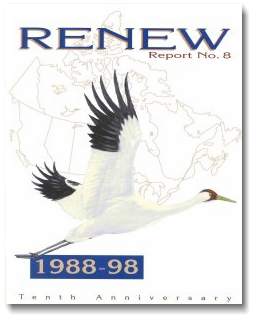

 
|
|
|
|
|
||
|
|

Watching Whoopers: Monitoring Crucial To Recovery
Protecting the feeding, nesting and wintering habitats of a species is essential to its survival. In the case of migratory species, whose ranges can span thousands of kilometres and many borders, tracking where and when they travel on their journeys is a complex task that requires widespread and often international cooperation. Migration monitoring is crucial to endangered species such as the whooping crane, whose numbers total fewer than 200 in the wild. The only wild breeding flock of "whoopers" flies 4,000 kilometres each spring and fall between Wood Buffalo National Park in the Northwest Territories and Aransas National Wildlife Refuge near Corpus Christi, Texas. Aware that even the slightest impact anywhere along this route could devastate the tiny population, scientists with Environment Canada and the U.S. Department of the Interior are studying the flock's migration under a joint Canada-U.S. recovery program. Environment Canada's Canadian Wildlife Service became involved in whooping crane monitoring in 1954, when the nesting site of the last migrating flock was discovered in a remote corner of Wood Buffalo National Park. The 21 members of the flock were the last whooping cranes in the world, a smaller non-migrating flock in Louisiana having died out in the previous decade. In 1986, Environment Canada established a Whooping Crane Hotline for volunteer observers to report their sightings. Hunters, farmers, bird watchers and others remain the foundation of the monitoring program today. Click to enlarge. In addition to maintaining a computerized database of observations, there have also been efforts to collect whooping crane eggs for captive breeding programs, band or fit birds with transmitters, conduct nest counts by airplane, and visit sites where banded birds from the Wood Buffalo-Aransas flock have been spotted. Because more than half the breeding pairs have at least one banded member--the oldest a 21-year-old female--scientists have valuable information on the history of the species' habitat use, including the discovery that families tend to use smaller wetlands than non-breeding birds and often return to the same site year after year.
This information is used to discourage development near wetlands used for feeding, nesting and wintering, encourage farmers to protect the harvested grain fields whoopers use for food during migration, restrict the hunting of look-alike sandhill cranes when whooping cranes are passing through, and scaring birds away from areas where there has been an outbreak of avian cholera or other contagious disease. 
Since recovery efforts began, the whooping crane population has made a slow but steady comeback, doubling in size over the past 13 years. But the battle is far from over. Concerned that a toxic spill could occur on the shipping canal that runs through Aransas Refuge, scientists are working to establish two new breeding populations elsewhere in the United States. A non-migrating flock of 56 captive-bred birds has already been established in Florida, but the birds are too young for scientists to determine whether they will breed. The next challenge--to put a migrating flock in place in Wisconsin--has scientists on both sides of the border experimenting with the use of trucks and ultralight planes to teach captive-bred cranes the migrating behaviour they would normally learn from their parents. The ongoing trials and tribulations of the whooping crane recovery project are chronicled at the Journey North web site www.learner.org/jnorth/index.html, a tool used to teach students about the migration patterns of various species.
Sometimes, even the best efforts of wildlife administrators, naturalists and private landowners are not enough to bring an endangered species back from the brink of extinction. Over the past 20 years, 16 of the 307 species designated as at risk in Canada have been de-listed or moved to a lower category of risk, while the same number have moved the opposite direction.
Hunting and harvesting bans, habitat conservation and captive breeding programs are some of the tactics recovery teams use to help restore populations, but none guarantee the conservation of a species over the long term. With a species whose population has declined significantly, other less easily controlled factors--such as competition for food or habitat, severe weather, natural predators, parasites, and collisions with vehicles--become increasingly important. Because wildlife populations are influenced by a combination of factors, successful recovery efforts require an understanding of all aspects of how a species interacts with its environment. This has spurred efforts, in recent years, to address recovery not only through a single-species approach but also through recovery plans that consider the needs of other wildlife species and humans in the ecosystem. 
Recovery efforts are highlighted in the 1988-98 RENEW Report, as well as on the endangered species website at http://www.cws-scf.ec.gc.ca/es/renew/RENEW97_98/eng/index.html |
|
|
Home | Air | Atmospheric Science | Climate Change | Environmemental Action | Habitat | Pollution | Species at Risk | Technology | Water | Weather | Wildlife |
|
|
| Help
| Search
| Canada Site |
|
||
|
The Green LaneTM, Environment Canada's World Wide Web site
|
||
|
|
||
|
|
||